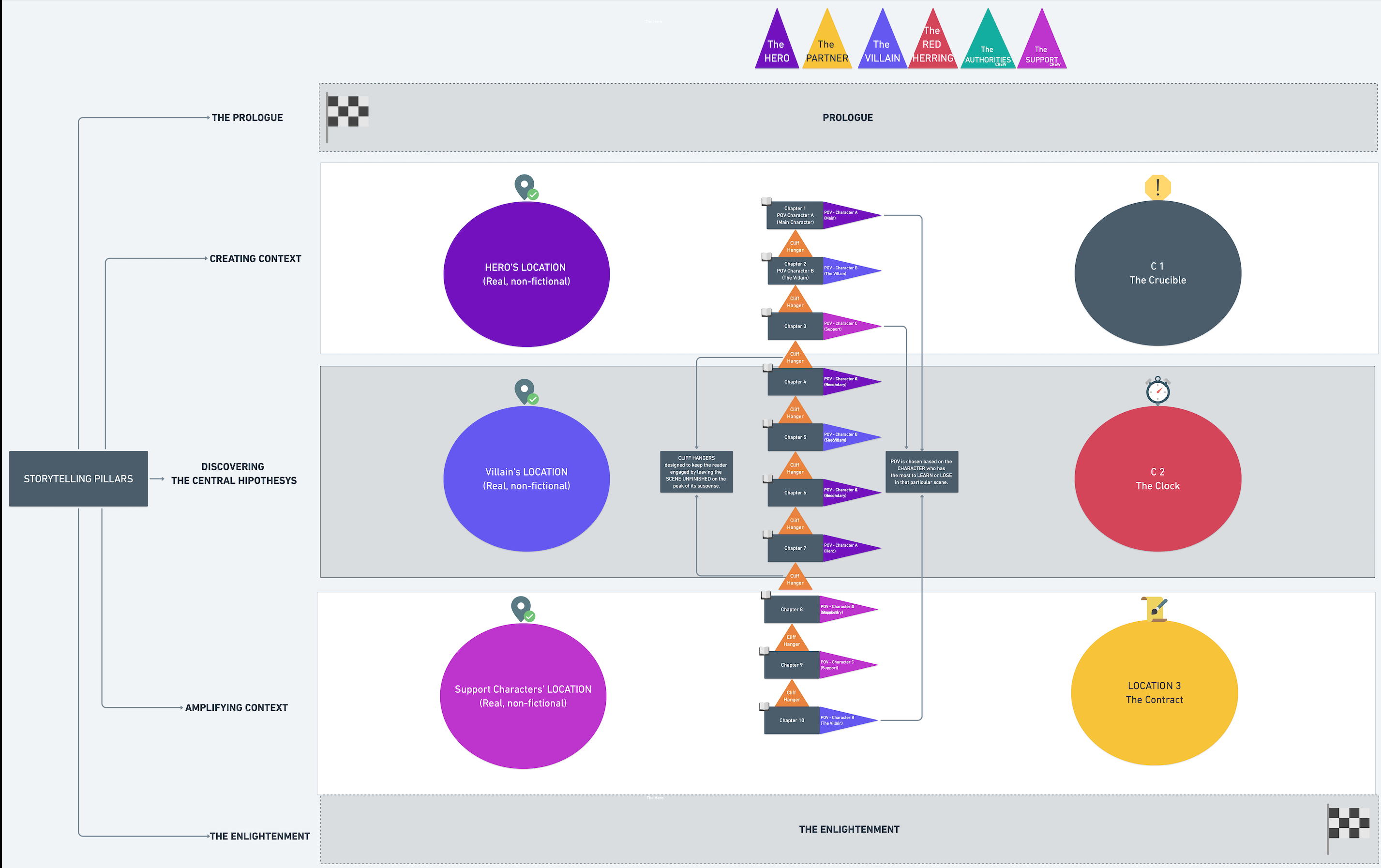
Dan Brown is an American author best known for his thriller novels, including:
- The Da Vinci Code (2003),
- The Lost Symbol (2009),
- Inferno (2013) or
- Origin (2017).
His novels are treasure hunts that feature recurring themes of cryptography, art, science and disruptive discoveries with the potential of global impact.
His books have been translated into 57 languages and, as of 2012, have sold over 200 million copies. Three of them, Angels & Demons, The Da Vinci Code, and Inferno, have been also adapted into films.
WHAT’s the STRATEGY that stands behind all this success?
There is a complex answer for a simple question as the one above, however, I have managed to clarify a part of it and that part is related to the storytelling angle. In this article you will learn more about the strategic pattern that he uses in his writing style, which I put together after I analysed the sources below:
- His novels collection;
- His thriller writing Masterclass;
- A few interviews regarding his work and techniques;
DAN BROWN’s HOT SAUCE as an AUTHOR
One of his readers in a media interview mentioned that “Reading Dan Brown is like eating your vegetables but feeling like eating cake”. The analogy was referring to the cultural angles that his novels are covering, where I would add the fact that apart from his fictional characters and the storyline, everything else in his books is documented and relying on facts.
ICONIC HISTORICAL PLACES:You will explore emblematical places in Dan Brown’s novels such as Palazzo Vecchio (Florenza, Italy), Basilica Saint Pietro (Vatican) or Guggenheim Museum (Bilbao), as well as renowned art works of Lorenzo Bernini, Dante Alighieri, Rafael Sanzio or Leonardo da Vinci, and furthermore, some of the boldest thesis that the humanity has discover to this day, all connected in a life-changing treasure hunt.
Science, art, politics and religion – all together in an emerging plot that enhances both, the osmosis and the discrepancies between them.
The hot sauce that drives people’s engagement has to do also with the stake of the stories. In each of his novels, the central thesis involves a disruptive discovery with the potential of global impact:
- The Da Vinci Code: Rethinking the fundamental beliefs of Christianity;
- Inferno: A global pandemic to re-balance the Earth’s fast growing population;
- The Digital Fortress: Global surveillance implications and its network;
- Deception Point: Questioning NASA’s discovery of finding life outside Earth;
- The Lost Symbol: The quest for illumination of the 18th Century’s intellectual elite combined with the nowadays noetic science’s discoveries;
- And so on;
WHAT YOU WILL LEARN:
At the end of this article you will learn the answers for the questions below, meant to help you improve your WRITING STRATEGY and STORYTELLING SKILLS.
- What is the role of the Storytelling Pillars: The Prologue, Context Creation, The Central Hypothesis, The Amplification of Context and The final Enlightenment?
- How Dan Brown strategically builds his Characters (The Hero, The Villain, The Partner, The Red Herring, The Authorities, The Support Crew)?
- What is the role of BRANDS and how he uses them to build on characters?
- What is the role of ART and HISTORY and how he’s choosing them to amplify his thrillers?
- What are the 3Cs and how they enhance the action?
- How can a good POV STRATEGY intensify the suspense?
- What are the Cliff Hangers and how they help in engaging the readers?
- How is THE PACE modulating the tension in storytelling?
- How does CORNERING the characters enhances creativity?
- What is the role of CULTURE and, in this particular case, the effect of FICTION READING on your SELF DEVELOPMENT?
After reading The Lost Symbol and connecting the dots with his other books and masterclass, I created the diagram below to highlight his STORYTELLING STRATEGY in a visual way:
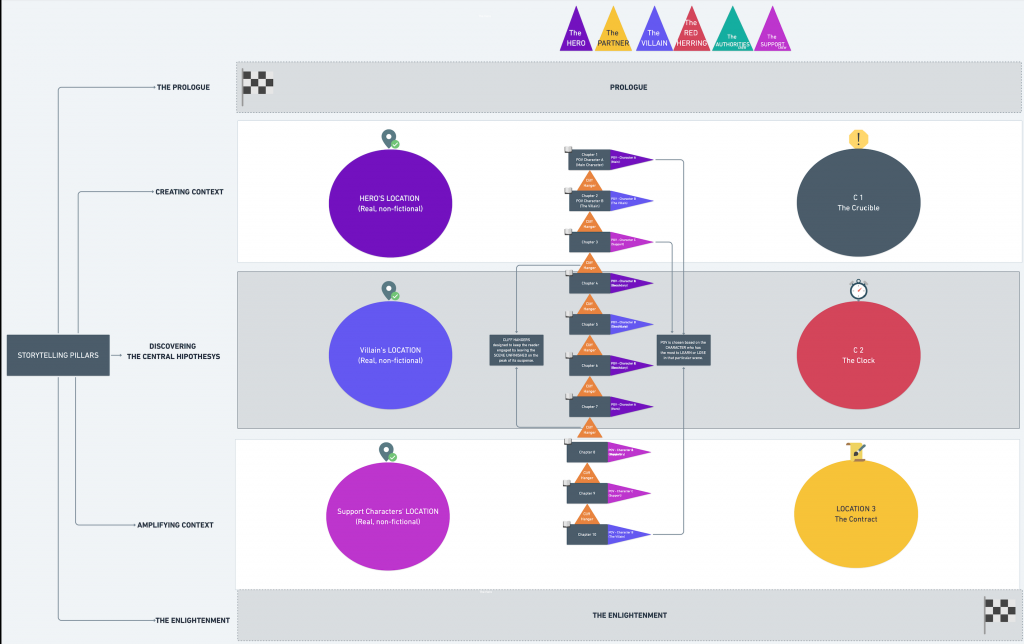
1.The of role of the Storytelling Pillars:
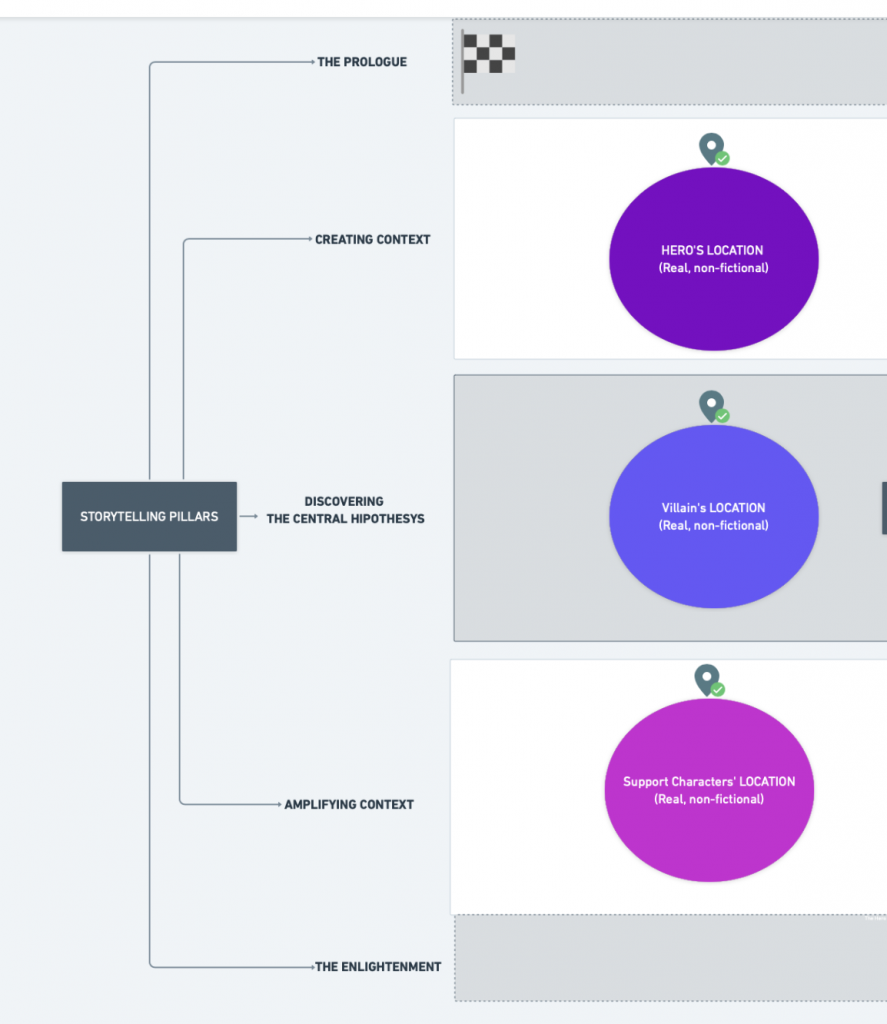
- The Prologue: is the beginning scene meant to capture the readers’ curiosity and engage them into reading the book. This scene in Dan Brown’s novels is always embossed by a big controversy. The characters that are taking part in this scene have as well a critical role in the story, reason why the tension is amplified.
- The Context Creation: captures the following chapters meant to build on the prologue scene progressively to create a rational link between the events. It creates the space of the story, the relationships’ dynamic and the reasoning behind the actions.
- The Central Hypothesis: presents the core discovery. The universal truth that is promised to be revealed by the end of the book through solving the quest. In each of Brown’s stories, these discoveries are meant to disrupt the reality as is presented in the beginning of the book, through a turning point that creates a paradigm shift.
- The Amplification of Context: contains all the scenes following the central hypothesis. The action that takes place in these chapters is meant to intensify the tension, create new road blocks and challenge the hero in his quest to solve the puzzle;
- The final Enlightenment: presents the ultimate discovery and the disrupting effects that follow. In Brown’s novels the enlightenment phase makes the reader gravitate on some profound existential questions or divergent angles that have a fundamental role in how we, as humans, perceive the world that we live in.
2.THE RULES for CREATING THE CHARACTERS:

- The HERO: Doesn’t necessarily have to be responsible or directly involved in the main DYNAMIC of the plot, but he always has the KEY ROLE in solving the quest.
- THE PARTNER: has to be the complementary character for the hero. He or she has to have the right set of skills that complete the hero’s resources. This is a mandatory trick that Dan’s using in his novels to create a change in perspective when road blockers occurs and offer a different angle, when such thing is needed.
- The VILLAIN: Has to be build as a worthy opponent for the hero. A key factor in Brown’s book is that the villain is always a MASTERMIND with a tremendously important role in the MAIN DYNAMIC. Another technique to enhance suspense used by Dan Brown is sketching the villain as a “faceless power-broker”, a master puppeteer without a real identity that makes the reader wonder who is behind everything.
- THE RED HERRING: The Red Herring is a term used in novels writing for what we call THE DISTRACTOR, the character that seems most obviously to be in charge for the crime, yet the Red Herring’s role is always to mislead the reader regarding the villain. The technique is meant to in amplify the dramatic effect of the end scene, when the truth is uncovered.
- The AUTHORITIES: The authorities in Brown’s novels are the high-end type of elite, such as: CIA, FBI, NASA or NSA, once because all of his plots involve problems with national or global security impact, and second, because they have an important role of intensifying the tension by creating or removing road blockers, depending on the scenes.
- The SUPPORT CREW: Involves all the characters that do not have a lead role in the plot, yet they offer alternative angles that help the reader visualize the scenes from multiple perspectives. You’ll learn more about their importance at the POV STRATEGY below.
3. The role of BRANDS in the characters’ creation process:
A BRAND by definition is the sum of perceptions in the mind of a customer.
We could say it’s a complex mix of ingredients that involve: values, archetypes, image, taste, sound, market positioning & many more, mix that sharpens the perception of one’s over a brand and not just the brand, but also over the people that consume that particular product or service.
Now, why am I telling you this? Because from a certain angle, this is also one of Dan Brown’s procedures to build on its characters’ personality.
1. IMAGE TRANSFER TECHNIQUE TO CONTOUR THE CHARACTERS
Brown knows very well that BRANDS have the power to amplify a character’s personality and he’s leveraging them to do so. The technique that he uses is the standard IMAGE TRANSFER: attaching the image and features of an international brand to a fictional character helps the reader visualize the characters closer to what their author intended them to be.
The procedure is likely similar to another storytelling trick, that I call The reversed storytelling model which helps in the process of knowledge transfer through analogies. (*Learn more about it in the article SETH GODIN’S STRATEGY on approaching over 20 types of audience with ONE SPEECH.)
2. HOW ABOUT PRODUCT PLACEMENT?
Well, when it comes to BRANDS, besides storytelling we are talking about product placement, and when you count over 30 uses of the word BlackBerry and 23 uses of Volvo in 600 pages of text, you know there’s more than just character amplification involved right there.
Below you will find a list of the brands endorsed in The Lost Symbol. They might not be all product placements, but the two mentioned above have been used way too many times to make you consider the fact that we might be talking about a potential arrangement that has been signed in the backstage.
- Harvard University
- Princeton University
- Yale University
- Lexus SUV
- Cadillac
- Volvo
- BlackBerry
- Falcon 2000EX
- Pratt & Whitney
- Phillips Exeter Academy
- Harris Tweed Clothing
- Beltway Limousine
- Kiryu Textiles
- Bookspan Book Club
- Redskins Team
- Disney World
- Mickey Mouse
- Coca Cola
- Cartier
- CNN
- iPhone
- Ivy League
ART, CULTURE & HISTORIC REFERENCES
- Piranesi
- Savonarola
- Bugarini
- Lux Aeterna – Giuseppe Verdi
- Ermitaj
- Vatican Museum
- New York Metropolitan
- Pierre L’Enfant
- Benjamin Franklin
- George Washington
- Theodore Rosevelt
- St. Graal
- Louvre Museum
- Charles Darwin
- Smithsonian National Museum of Natural History
- San Pietro Basilica
- Dante’s Inferno
- Albert Einstein
- Bohr
- Stephen Hawking
- Isaac Newton
- Constantino Brumudi – Washington’s Apotheosis
- Michelangelo
- Sistine Chapel
- Adoration of the Magi
- St. John the baptist
- The Pantheon
- Horatio Greenough
- The three graces by Antonio Canova
- Phaistos’ Disc
- Voynich Manuscript
- Dorabella Cipher
- Sant Angelo’s Castle
- Lorenzo Bernini
- Gutenbergs Bible
- Giant Bible of Mainz
- John White Alexander – The book evolution
- The Francmasonic Cipher
- Albrecht Durer’s Melancholia
- Francis Bacon
- The Akedah Knife
What I would add on top regarding the BRANDING angle is that Dan Brown’s books can also portrait a great opportunity for city branding, especially if you consider the stories he embodies within the locations. It makes you wanna revisit the places, this time with a different pair of eyes.
- The Da Vinci Code (2003): Vatican City/ Italy.
- The Lost Symbol (2009): Washington, USA.
- Inferno (2013) Florenza, Italy.
- Origin (2017), Bilbao, Spain.
- Digital Fortress (1998), Seville, Spain.
- Angels and Demons (2000), Rome, Italy.
4. What is the role of ART and HISTORY in choosing the locations for a story?
1. HISTORY FILLS THE STORY WITH MEANING
One of the reasons Dan Brown is using iconic locations filled with historical meaning is due tot he fact that they amplify the dramatic effect in his stories. All the locations are curated with intention and according to the events they carry with them.
2. THE PSYCHOLOGY OF RELATABILITY
When you choose a real location with particular events built into its walls over a fictional one, it might not challenge the imagination, but it will definitely create mystery and tension, especially if the reader visited or read about it before. What happens is that that place becomes relatable and it makes the reader picture himself through the eyes of the characters while reading the story.
3. READING ABOUT A POTENTIAL REALITY
Another reasons why Dan Brown anchors his stories and events in real places and institutions instead of fictional ones, it’s because it builds up the suspense. When we read about a story that happened in a location that exists, the action is mentally projecting us in a potential reality that we might experience at a certain point in our lives.
4. LOCATIONS AS CHESS BOARDS
The author’s locations are highly connected with the central quest of the story and they play a tremendous role in the plot. With the right strategical moves they are offering opportunities to move forward and discover the next clue.
5. ART IS USED AS A UNIVERSAL LANGUAGE
Besides the places, art works and science theories are used as translators into the treasure hunt. They are all part of a final discovery and each of them contains a message meant to take the reader closer to the truth.
5. What are the 3Cs and how are they creating engagement?
The 3 C’s are the clock, the crucible, and the contract.
- The clock represents the sense of urgency and the fact that the hero is lacking time. It encourages fast action taking that creates suspense and adrenaline.
- The crucible means the hero has a tough condition and a worthy opponent; It’s the technique of cornering the main character by leaving no alternative to escape the situation except by jumping into the action. In storytelling, the crucible is meant to create empathy and emotional engagement.
- The contract represents the author’s promise to the reader. The more explicit it is, the bigger is the readers’ engagement. In his stories, the contract gravitates around a particular action to take place or a critical information to be unveiled by the end of the novel. The role of the contract is to maintain the curiosity and the reader engaged by the end of the story.
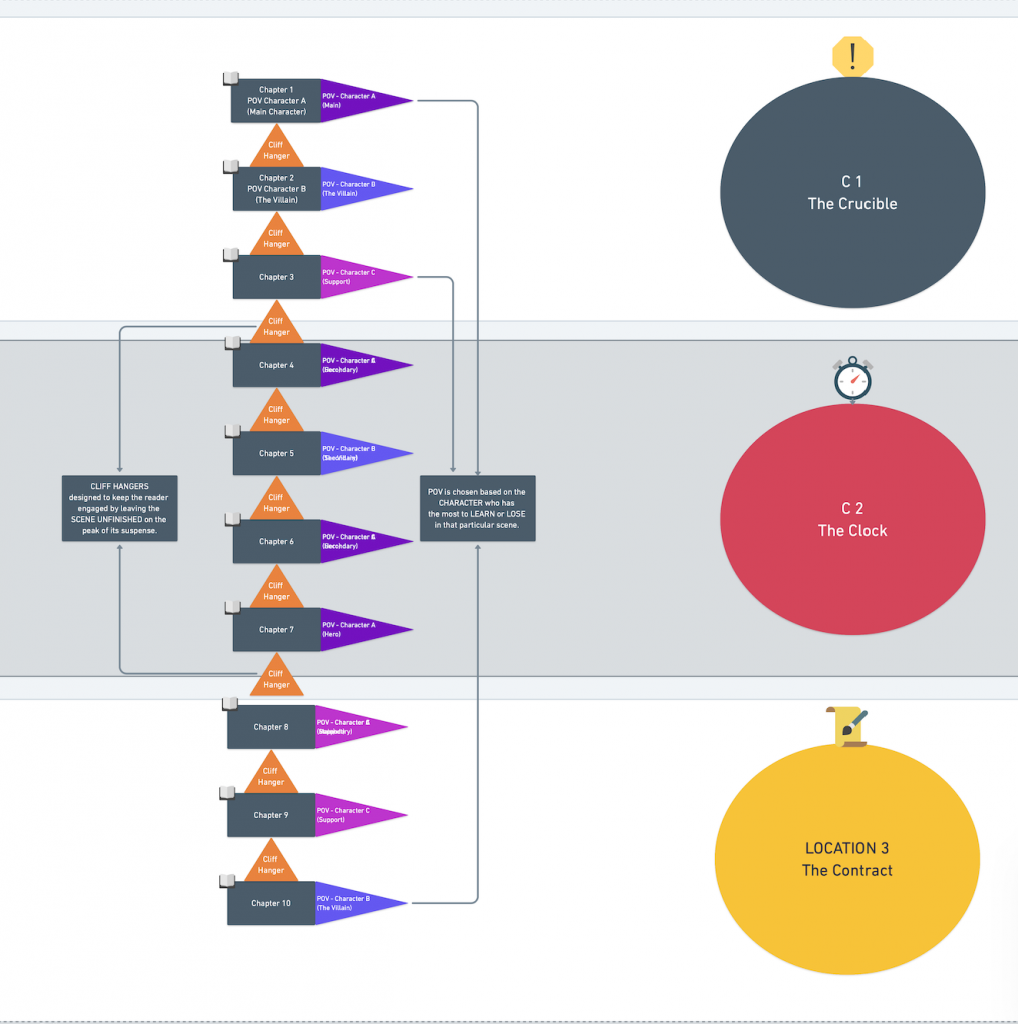
6. The particular POV (point of view) strategy that Dan Brown is using to amplify the suspense.
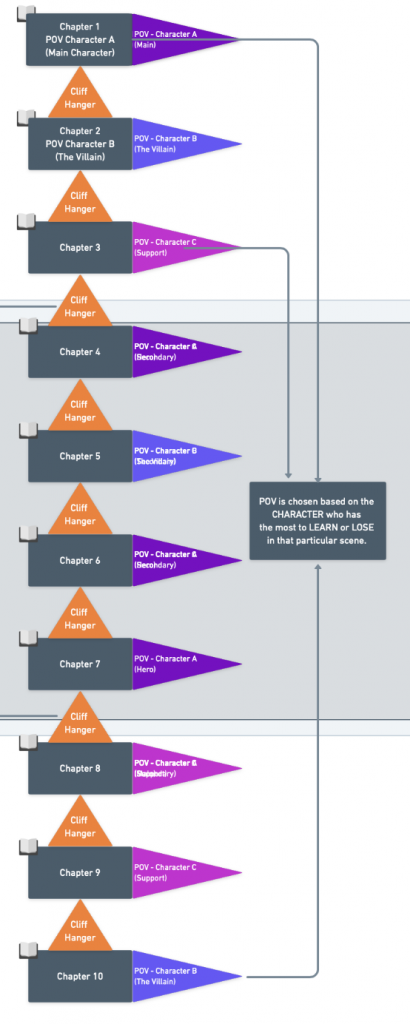
- THE STAKE OF THE CHAPTER DECIDES ON THE USED POV
What I noticed in Brown’s writing style is that he switches the POV in each chapter depending on the information that he wants to unveil. Compared to other authors’ writing styles that stick to one POV, Dan Brown is using a multiple perspective technique depending on the scene setup and the core message that needs to be delivered in that scene.
The criteria on which he choses the POV for each chapter depends on the character that has the most to lose or to win.
For example:
- If there’s a secret that isn’t meant to be revealed yet, he’s choosing the character that knows the least about it;
- If he wants to build on a character’s personality, he’s switching to the character’s POV and amplifies his profile through decision making and the values by which he filters the ongoing situation.
- Support characters for example are used to amplify the tension and take the storyline further when there’s none of the main characters involved in a particular important scene.
2. THE REASON HE USES PARALLEL ACTION PLANS (locations)
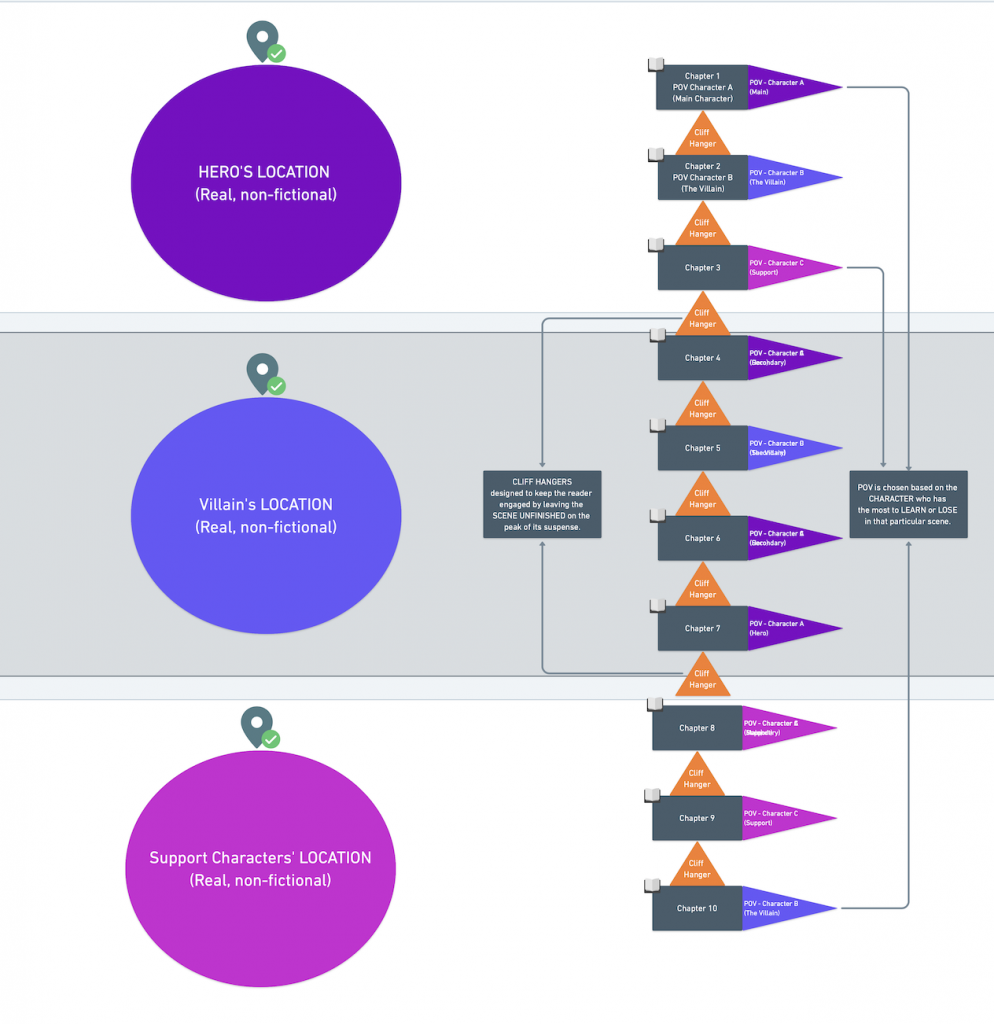
What you will notice in Dan Brown’s novels is that he always tells the story from multiple action plans. This particular technique has, both, the role of clarifying the course of action and in some cases the opposite role of dissimulation. When it comes to dissimulation, what he does is redirecting the reader’s attention to angles that could be misleading, yet with the final purpose of amplifying the effect of the final discovery.
7. What are the Cliff Hangers and how do they help in readers engagement?
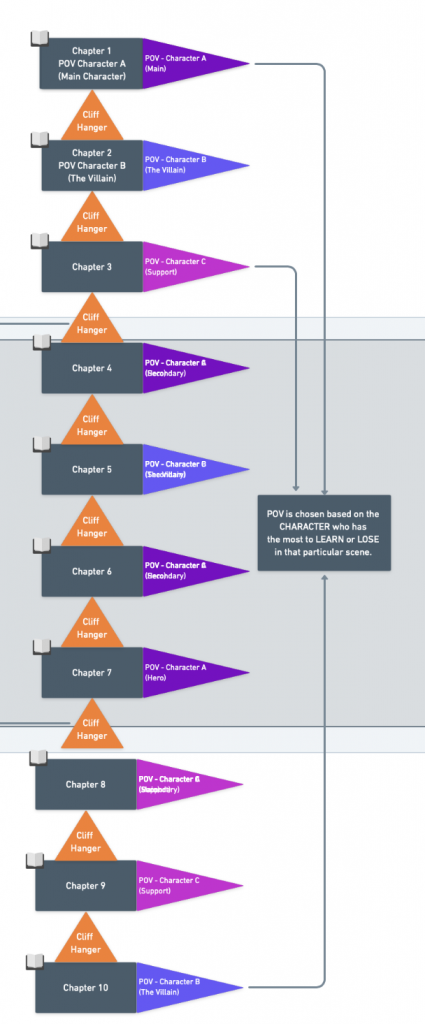
In storytelling, cliffhangers are a combination of high stakes, twists, conflictual dynamics and scene reversals. Just as teasing is used in marketing strategies, cliff hangers are those particular story cuts in the middle of the action, meant to make the reader move to the next chapter as fast as possible.
This is one of the tricks that the author is using for each chapter end to keep his readers engaged and curious to turn over the page and learn more. What’s even smarter in his strategy is not just the fact that he leaves you hanging on the curiosity of what happens next, but right after you turn over the page, you realize that he’s also switched the POV, so…surprise! You have to read 2 more chapters before finding out what you are actually expecting.
And there you are 5 chapters later still reading, caught in this mouse trap of…curiosity.
8. How is THE PACE modulating the tension in storytelling?
Another important aspect for readers’ engagement is the pace of the action. You have to find a balanced pace that tempers the adrenaline rush scenes with lighter chapters that follow. This is one of the fundamental details he is keeping into account. After analysing The Lost Symbols on a granular level, I noticed that each powerful chapter was followed by a different plan of action meant to temper the tension and give the readers a “pause to catch their breath”.
9. How does CORNERING the characters enhances creativity?
One of the things that Dan Brown confirmed in one of his interviews is “cornering” his characters with no way to escape. He does it to push himself towards finding creative ways for solving a situation, when it seems like there’s no options left. He says the trick develops one’s capacity of innovative thinking at the same time.
10. What is the role of CULTURE and, in this particular case, the effect of FICTION READING on your SELF DEVELOPMENT?
Movies, songs, theatre or opera plays, art works or books have the power to create empathy scenarios. This is meant to be one of the culture’s most important roles: to educate humanity not just in terms of perceived value, but also in terms of emotional intelligence. All these artistic creations are showing us that we are not alone in facing life’s particular challenges and that out there in the world, there are other people confronting the same problems as we do.
Each time you are watching a movie or reading a fiction book you are exercising your empathy skills by walking in the shoes of the character you are reading about. In addition to movies, books are great for they develop your imagination and creativity. When you are reading about people, places and particular actions, you don’t have the ready made screen play in front of your eyes, so you have to create it yourself by imagining it.
BOTTOM LINE – I do believe that up to a certain point, culture has the tremendous power to educate humanity, where the other authorities have failed doing it.
Culture can be complementary to our experiences, helping us to better understand our peers and the demons that stand behind their edgy or usual behaviours. It could be the consciousness that helps us understand how to support them in certain moments. We realise it’s because of it in those particular situations when we know how to do help them not because we have been ourselves through those difficult situations before, but because we have experienced them throughout the pages of a book we have just read or through the theatre play that we have watched yesterday afternoon.